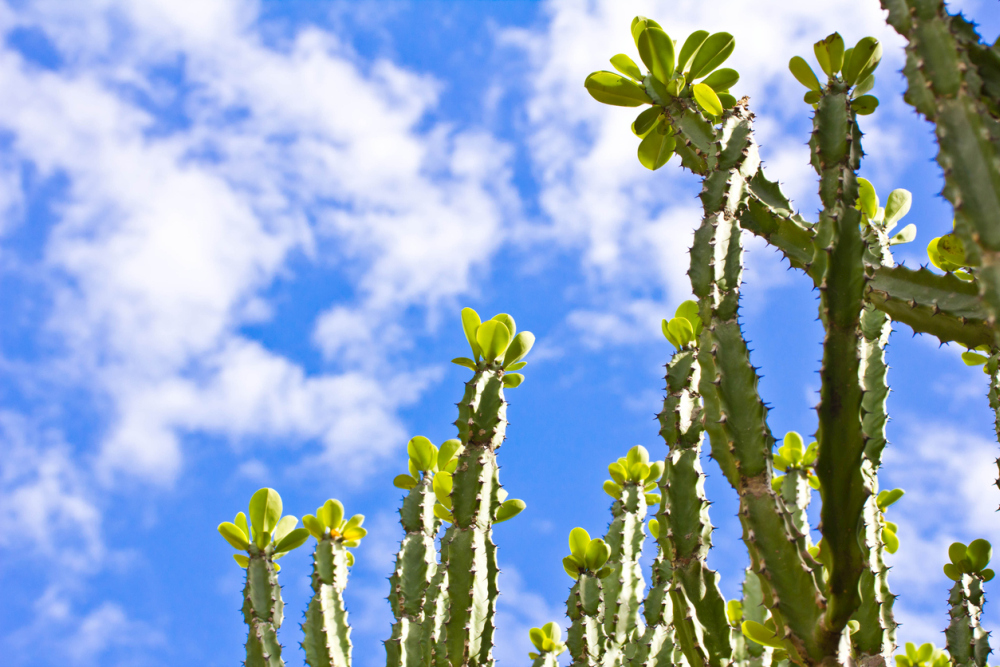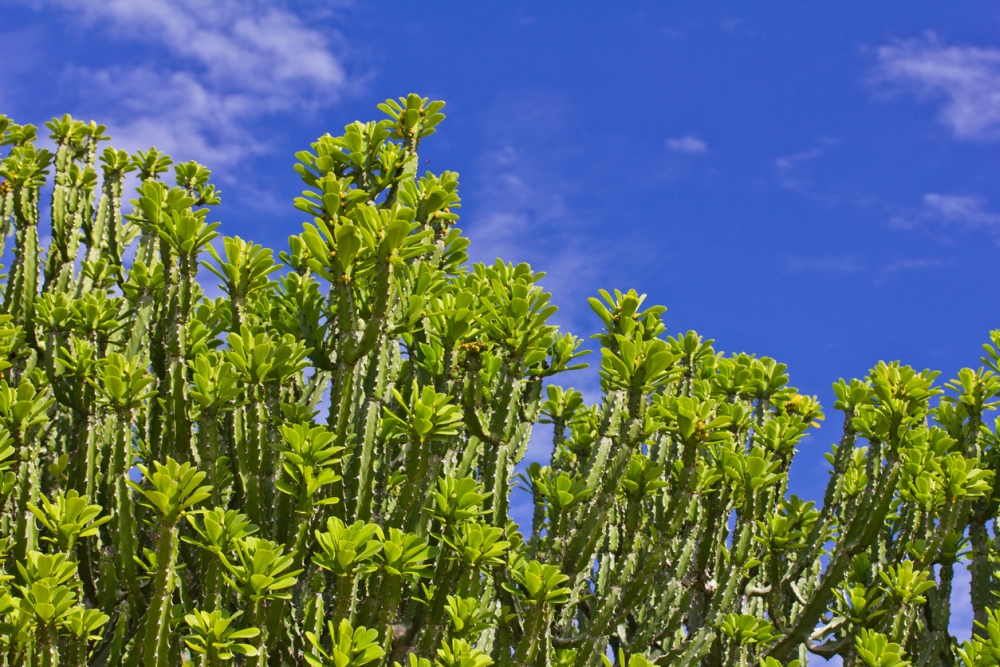Euphorbia Neriifolia: How to Grow & Care for the Indian Spurge Tree
Most Euphorbia species help create a wondrous setting when grown in gardens for landscaping. With cactus-like attributes, this perennial succulent has not only yielded splendid results outdoors but has also maintained a sturdy posture as a houseplant. And when it comes to self-sustenance, the Indian SpurgeTree is one of the few species you should be looking to plant in your garden. Let’s check out the kind of caring routine it needs to grow and look lush.
More About the IndianSpurgeTree
Euphorbia neriifolia, also known as Hedge Euphorbia or Indian Spurge Tree, is one among the over 2,000 species that belong to the Euphorbiaceae family. When cultivated, it looks more like a shrub since it has the traits of a perennial succulent plant. But this Euphorbia species will still get acclimated to wild conditions and matures into a full-grown tree. The Indian Spurge Tree also goes by other names like:
- Milk Spurge
- Oleander Spurge
- Milk bush
- Dog’s Tongue
- Common Milk’s Hedge
- Holy Milk’s Hedge
This Euphorbia species is native to Central and Southern India. It also has some indigenous traces in Thailand, Sri Lanka, and West Bengal. It can reach anywhere between 18’-24’ inches even under neglect. In fact, caring for the Indian Spurge Tree excessively by overwatering, for instance, can rapidly ruin its lifecycle. We’d recommend this hardy variety to beginners who don’t want to start off with needy and delicate houseplants.
Indian Spurge Tree Caring Instructions
Flowering & Fragrance
A question commonly asked by newbie gardeners is: Does the Euphorbia plant produce flowers? The answer is yes. But the blooming cycle varies depending on the species you’re looking to grow. For the Oleander Euphorbia, the branched stems will hold clustered flowers that appear to have a glossy texture and look yellow-green. These flowers might bloom during springtime, but won’t last forever and don’t carry any scent.
Light & Temperature
Being a perennial succulent, the Indian Spurge Tree thrives in warm environments and can even survive in high temperatures, depending on the genetic makeup of the plant and its environment. While it prefers midrange humidity levels and loves bright light, this Euphorbia species also appreciates a little bit of shade. When growing indoors, you want to place the growing medium near a south-facing window so it receives plenty of light. If the temperature drops below 60 degrees Fahrenheit, then the foliage will start to turn brown or yellow due to wilting.
All of its growth stops when the temperature becomes too cold for it. The shrub will appear dormant when the temperature drops below 50 degrees Fahrenheit because it cannot continue to grow in that environment. If you want your Oleander Spurge to grow normally and live for decades, make sure the temperature remains between 75-80 degrees Fahrenheit.
It needs to grow under this temperature range if you want to grow impeccably without chances of fungal infections. The Indian Spurge would typically do well under USDA hardiness zones 10a to 11b. When it’s summer and the sun is hitting your window sill so hard, you can place the growing medium in the balcony, especially if there’s some partial shade during the afternoon hours.
Watering
Most euphorbia varieties can withstand a little bit of neglect when it comes to watering needs. And that’s because it holds the adaptation to store water in the stems. On the other hand, this perennial succulent is quite sensitive to the effects of overwatering. The most common effect of overwatering is that the soil can become waterlogged and infertile since the essential nutrients will get washed away. And that makes it difficult for the blooming cycle to take place. Another effect of overwatering is that the plant will most likely rot as a result of getting stuck in soggy soil for too long.
A closer and possible outcome wilting or stunted growth due to extreme humidity in the surrounding environment. The growth hormones of this Euphorbia species go into a dormant state during winter. And that is why it is crucial to limit the watering interval during this season so that the plant can get enough rest. Around early spring to the fallseason iswhen new growth emerges, so you want to gently moisten the soil whenever the first few inches feel entirely dry during these two active phases.
Fertilizer
If you’ve ever grown succulents, chances are you know about how quickly they grow and the importance of keeping them well-watered. However, one question that remains unanswered is “when should I fertilize my succulents?” This is a difficult question to answer, as there are many factors that determine when and how often to fertilize your Oleander Euphorbia plant.
If your potted Oleander Euphorbia is looking droopy and pale, it’s likely the soil is lacking a bit of phosphorus. The first thing to decide on when introducing fertilizer into your succulent garden is what type of fertilizer you should use. Succulents such as this Euphorbia variety are relatively easy to fertilize, as many different types of fertilizer will work well on them. The two most commonly used fertilizers are liquid and granular.
Granular work by introducing the pellets into the soil. This is generally done by lightly mixing the fertilizer into topsoil, and then watering in. Granular fertilizers are easier to use but must be regularly applied and reapplied in order to yield optimal results. Liquid fertilizers, on the other hand, are applied directly to the plants themselves using spray bottles. While these options are pretty viable, organic alternatives usually don’t seem to pose any harmful effects to the soil composition when used in moderation.
I tend to find a bone meal as the best organic plant food for perennial succulents because it’s rich in phosphorus. It helps transform sugars into starch, optimize the growth of cells, and create a perfect environment for photosynthesis which is responsible for chlorophyll production. Other plant foods you could consider include tricalcium phosphate, which is rich in calcium and phosphorus.
The compound actively acts as a nutritional supplement. The other inexpensive alternative is a 4:1 ratio of wood ashes to cow manure, which is rich in potassium. Both are great options to keep your potted Indian Spurge Tree healthy and lush. Or better still, you can use theMiracle-Groliquid plant food that suits many indoor succulents such as theJadeplant.
Soil & Transplanting
Picking the perfect soil for your perennial succulent plants can be a daunting task, especially when the growing conditions of where you live are flagrantly differing from what your Oleander Euphorbia is naturally accustomed to. It can be hard to tell what is the best type of soil in which to grow these specialty perennial variety plants. With that being said, it’s worth noting that perennials not only benefit from some watering and fertilizer, but they also need well-draining soils that retain moisture but drain excess water away fast enough.
Not to mention how particularly sensitive they are to over-watering which may result in rot or fungus infections on the stems.While the best type of soil for your plants depends on the specific plant you are growing, most perennial succulents prefer a potting mix that is composed of 50% loam and 50% sand or perlite. It’s best to use sandy soil with a pH that ranges anywhere from slightly acidic to neutral. Some species also tend to do fine in slightly alkaline some. This is one of the most useful soil structures if you’re looking for an overall well-draining yet moisture-retaining mix.
Also, succulents do well when their roots are exposed to air, so make sure that soil is not water-logged and stays aerated most of the time. And for that reason, some pro-gardeners choose to amend the potting soil with a 1/4 portion of vermiculite. Peat moss is also an organic option you can use to improve drainage. So, the bottom line is you need to focus on minting out the perfect succulent potting mix if you want to see your Indian Spurge Tree age gracefully. The only time you’ll need to transplant this Euphorbia species is only when it outgrows the original container.
Grooming & Maintenance
Maintaining the Indian Spurge Tree is fairly easy, even if you don’t have the natural talent to care for its regular needs. When growing indoors where light isn’t too bright, the growth hormones might signal the plant to grow in a leggy manner. So, you want to prune the stems just to keep them in perfect shape, and place the growing medium somewhere it won’t struggle to search for light. Get rid of any leaves that show signs of wilting or appear to suffer from fungal diseases.
Is the Oleander Euphorbia Toxic?
The milky sap from this Euphorbia species is categorized as poisonous and causes skin or eye irritation.Use protective gear when plucking off any unwanted parts to avoid any contact with the sap from the stems as it can cause skin irritation. It’s also toxic to pets when ingested, so you want to place the container far from your cat or kids. Ingesting parts of this plant causes stomach upsets and acute irritation in the digestive tract. After skin contact with the sap, you might develop rashes, redness, and feel pain. Despite the grave safety concerns, the sap has been proven to carry some antibacterial and antifungal compounds.
How to Propagate the Indian Spurge Euphorbia
The two easy ways to propagate this Euphorbia species are through seeds or stem cuttings. Stem cuttings carry a higher chance of yielding the best results sooner since seeds tend to take a bit longer to germinate. All you need to do when using the stem cuttings is follow these steps:
- Prepare the potting mix using instructions shared right under the soil and transplanting section.
- Wear protective gear to prevent the oozing sap from getting into contact with your skin.
- Dissect a fresh-looking stem cutting from the mother plant.
- Leave the cutting in the open overnight to give the wounds some grace period for healing
- Oftentimes, using a rooting hormone will speed up the growth of roots, especially when propagating a houseplant using stem cuttings.
- Moisten the soil to enhance the roots development process.
- Within a few weeks, the roots will have formed. You can transplant your Oleander Euphorbia from its original container to the ground once it’s stable enough and has grown a bit more in size.
Indian Spurge Tree: Common Pests & Diseases
Even though this Euphorbia variety is a hardy plant, it also prone to a few common issues such as root rot and algae growth which crop up as a result of overwatering. Before trying out commercial fungicides, you want to make sure the potting soil is well-aerated, and need to water your Oleander Euphorbia at the right intervals. Keeping your soil moist without letting it get soggy or causing continuous flooding, would help prevent these diseases. You might also occasionally have to deal with mealybugs, scale insects, and spider mites.
The infestation can grow rapidly if you fail to control them at an early phase. And the best way to eliminate aphids or mealybugs is to spray the affected areas with diluted neem oil or insecticidal soaps. If you’re looking for a natural way of controlling mass numbers, try sprinkling ground black pepper where they congregate. This will not harm the plant but it’ll discourage the aphids from sticking around. When it’s summer, scale eggs may be hatching in your garden where your Indian Spurge Tree is growing, so you want to be a little more careful around this season.

